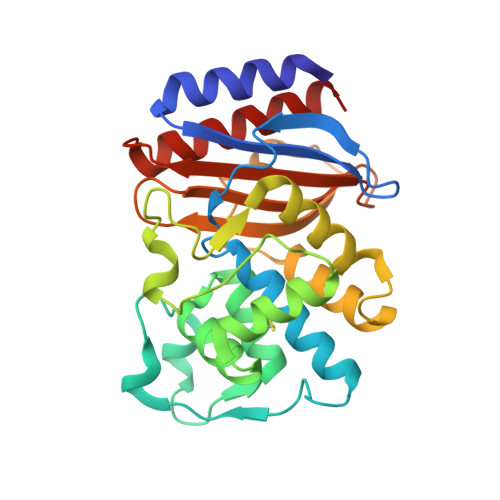An ultrahigh resolution structure of TEM-1 beta-lactamase suggests a role for Glu166 as the general base in acylation.
Minasov, G., Wang, X., Shoichet, B.K.(2002) J Am Chem Soc 124: 5333-5340
- PubMed: 11996574
- DOI: https://doi.org/10.1021/ja0259640
- Primary Citation of Related Structures:
1M40 - PubMed Abstract:
Although TEM-1 beta-lactamase is among the best studied enzymes, its acylation mechanism remains controversial. To investigate this problem, the structure of TEM-1 in complex with an acylation transition-state analogue was determined at ultrahigh resolution (0.85 A) by X-ray crystallography. The quality of the data was such as to allow for refinement to an R-factor of 9.1% and an R(free) of 11.2%. In the resulting structure, the electron density features were clear enough to differentiate between single and double bonds in carboxylate groups, to identify multiple conformations that are occupied by residues and loops, and to assign 70% of the protons in the protein. Unexpectedly, even at pH 8.0 where the protein was crystallized, the active site residue Glu166 is clearly protonated. This supports the hypothesis that Glu166 is the general base in the acylation half of the reaction cycle. This structure suggests that Glu166 acts through the catalytic water to activate Ser70 for nucleophilic attack on the beta-lactam ring of the substrate. The hydrolytic mechanism of class A beta-lactamases, such as TEM-1, appears to be symmetrical, as are the serine proteases. Apart from its mechanistic implications, this atomic resolution structure affords an unusually detailed view of the structure, dynamics, and hydrogen-bonding networks of TEM-1, which may be useful for the design of inhibitors against this key antibiotic resistance target.
Organizational Affiliation:
Department of Molecular Pharmacology & Biological Chemistry, Northwestern University, 303 East Chicago Avenue, Chicago, Illinois 60611-3008, USA.

















